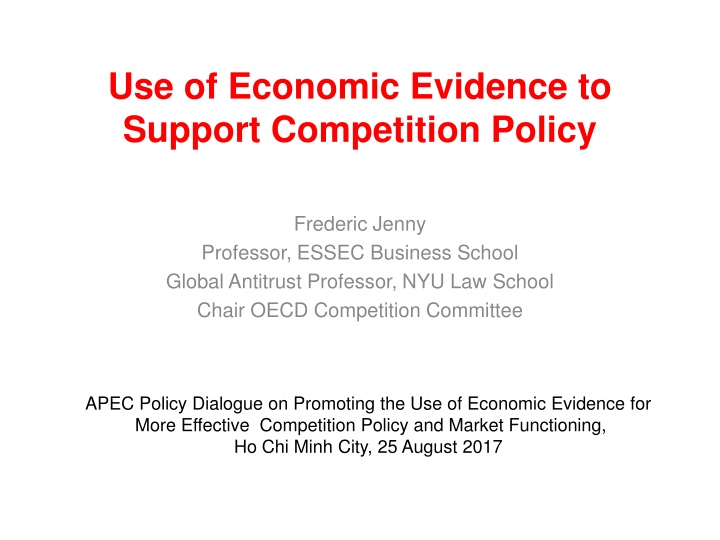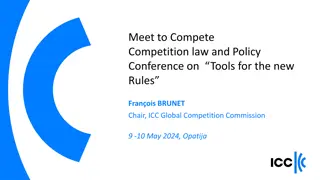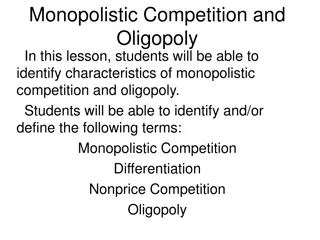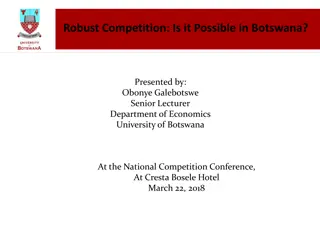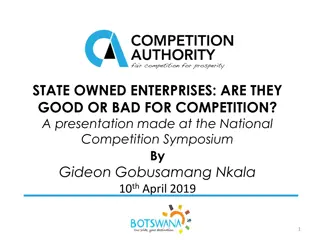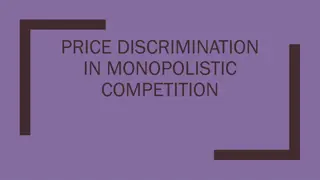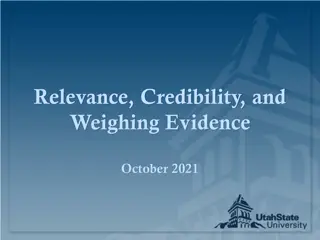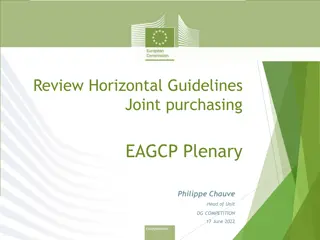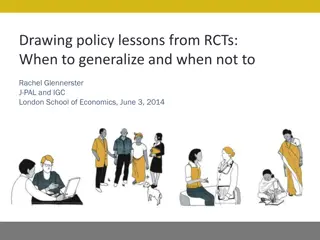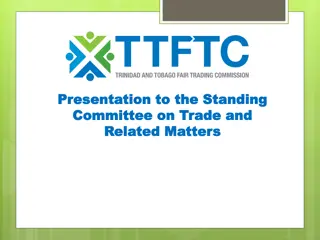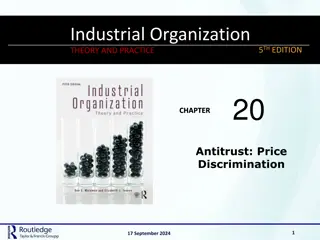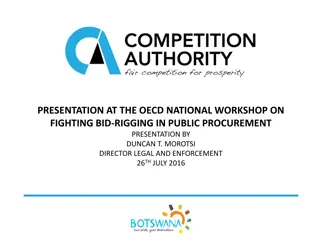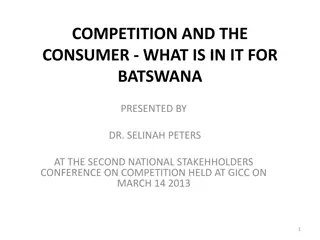Economic Evidence in Competition Policy
The role of economic evidence in supporting competition policy, covering topics such as competition law, antitrust issues, merger analysis, and the rationale for competition law. Learn about the benefits of competition, risks to competition, and the importance of maintaining a competitive market environment.
Download Presentation

Please find below an Image/Link to download the presentation.
The content on the website is provided AS IS for your information and personal use only. It may not be sold, licensed, or shared on other websites without obtaining consent from the author.If you encounter any issues during the download, it is possible that the publisher has removed the file from their server.
You are allowed to download the files provided on this website for personal or commercial use, subject to the condition that they are used lawfully. All files are the property of their respective owners.
The content on the website is provided AS IS for your information and personal use only. It may not be sold, licensed, or shared on other websites without obtaining consent from the author.
E N D
Presentation Transcript
Use of Economic Evidence to Support Competition Policy Frederic Jenny Professor, ESSEC Business School Global Antitrust Professor, NYU Law School Chair OECD Competition Committee APEC Policy Dialogue on Promoting the Use of Economic Evidence for More Effective Competition Policy and Market Functioning, Ho Chi Minh City, 25 August 2017
Issues to be discussed I) Competition law and policy - - II) What economics can bring to competition law - III) Economics and the use of legal presumptions - Presumption and allocation of burden of proof - Rule of reason - IV) Economic issues in Antitrust - -Anticompetitive agreements - Direct/ Indirect evidence - Structural - Behavioural - Abuse of dominance/monopolization - Market definition - Market Power - V) Economic issues in merger analysis - A) Horizontal mergers - Unilateral effects - Coordinated effects - B) Vertical mergers - C) Conglomerate mergers
Competition law and Competition policy Liberalization of International Trade International Competition Macroeconomic policy Competition Law Enforcement Institutional Design of the Authority Relationship with Courts Competition Advocacy Rule of Law Elimination of Corruption Promotion of a competition culture Regulatory reform Consumer Policy Industrial Policy National champions 3 3
Rationale for competition law Role of competition - Forces firms to reduce their costs - Forces firms to reduce their profit margins (pass onthe efficiency gains to consumers) - Pushes firms to innovate Benefits of competition - Protects the standard of living of citizens ( protects consumer surplus) - Guarantees economic freedom ( protects economic opportunities) - Forces firms to be as efficient as possible ( protects economic competitivity) Risks to competition - Powerful lobbies try to get legal protection from competition - Firms agree to restrict competition - Powerful firm try to abuse their market power - Firms merge t avid competing
Competition law: legal instrument necessary to ensure that competition prevails where it can play a useful role Prohibition of anticompetitive agreements between firms (horizontal or vertical) Prohibition of abuses of monopolies or dominant positions Merger control State Aid Control (in some countries) 5
II) What economics can bring to competition law enforcement 6
Elements of economics useful for antitrust: 1) concepts 1) Economics can be useful to the law is in supplying various economic concepts such as economic efficiency , opportunity cost , common costs , consumer surplus competition , etc. An economist can advance matters by explaining their meaning. Ex: What is economic competition ? Competition is an economic concept characterizing a market situation in which entry is free and every seller tries to increase its profits by offering to the buyers a better combination of price, quality, and service than the combinations offered by its competitors. Ex What is consumer surplus ? Maureen Brunt, Judicial Enforcement of Competition Law, OECD, Competition committee, 1997 7
Elements of economics useful for antitrust: 2) modelling The economist s method of analysis used in applied work. This consists essentially in a combination of the inductive and the deductive to form a syllogism which purports to model reality. The steps required are: first, to scan the raw facts (here, the raw evidence) second, to abstract the relevant facts third, to construct a model, using available theory, which has the form: since A + B are present, C follows. Ex: What is predation? Raw fact; low prices ( below cost) Model: a profit maximizing firm would never price below its variable cost. But it could sell at a price below average cost and above variable cost to minimize tis losses ( which is the same as maximizing its profits). Consequence: a price below variable cost can only be implemented by a firm if it tries to eliminate competition to recoup its inital losses. Thus it is anticompetitive. 8
Elements of economics useful for antitrust: 3) Measurement techniques 3) Economics can also be useful in providing measurement techniques. For example, economic methodologies to assess economic damage are relatively straightforward. When no documentary evidence, the measurement of the harm will require the use of a counter factual ( open to discussion). Ex: yardstick method ( counterfactual is a similar competitive market) Ex: before and after method ( counterfactual is a different competitive period) For a number of violations, the economic methodology to assess damages is open to scientific controversies. 9
III) Economic analysis and the use of presumptions
Per se versus rule of reason approach in competition law 1) A per se approach to competition law prohibits a particular practice in all cases ( for example resale price maintenance). It thus assumes that the practice is always anticompetitive. 2) However, a large number of practices are a priori ambiguous ( ex low prices may be the result of intense competition or signal a predatory practice). 3) The per se approach then entails the risk that a practice will be deterred or sanctioned even when it is procompetitive (type I errors) 4) An alternative approach is to prohibit practices only if they have the effect of restricting competition and rely on the Competition Authority to apply economic analysis to the facts of the case to establish if the practice was in the circumstances in which it was implemented anticompetitive. This is the rule of reason approach 5) But the rule of reason approach requires the examination of a lot of data sometmes difficult to get for the competition authority), is rather resource intensive and prone to the risk that the competition authority may fail to establish that the practice was in fact anticompetitive ( type II errors)
Designing an optimal system of competition law 1) Deterrence as the objective of competition law 2) Additional costs of enforcement in case of imperfect information : Risk of over deterrence ( type I errors); risk of under deterrence ( type 2 errors) with costs associated with each type of error 3) More information leads to lower risk and cost of errors. But information is costly. The rule of reason judicial standard and the per se judicial standard require different levels of information collection. 4) The legal uncertainty (sometimes associated with the rule of reason approach) may result in an inability of firms to anticipates which practices are legal or illegal and therefore to conform to the law. It therefore undermines the deterrence effect of law enforcement. Question : what is the optimal level of information gathering ? 12
Use of presumptions to mitigate the cost of the rule of reason ( more economic) approach A presumption has two effects: - it simplifies the standard of proof market share has a dominant position; therefore if it is established that it has more than 60% market share there is no need to establish that it has market power ( ie that it could maintain prices at a leel above the competitive level without provoking entry) Ex : it is presumed that a firm which has more than 60% - it determines who has the burden of proof presumption is rebuttable, it would be up to the firm to demonstrate that in spiteof its large market share, it is not able to price above the competitive level Ex: in the above case, if the dominant position
Different types of presumptions 1) Evidentiary presumptions The principal reason for creating an evidential presumption of X is the high probability that X is true in all or almost all cases. This means that it would needlessly incur cost for a party to prove what is already expected: that X is true in the particular circumstances of its case. Instead, the law conserves time and resources by simplifying the process: the other party is required to show that X is in fact not true. This labour-saving aspect of presumptions is arguably their most important function. Ex: 60. In the specific case of a parent company holding 100% of the capital of a subsidiary which has committed an infringement, there is a simple presumption that the parent company exercises decisive influence over the conduct of its subsidiary (CJEU Case C-97/08 P Akzo Nobel NV and Others v Commission of the European Communities)
Different types of presumptions 2) (Rebuttable) substantive presumption Example: exchange of information 81 According to settled case-law, it is sufficient for the Commission to show that the undertaking concerned participated in meetings at which anti- competitive agreements were concluded, without manifestly opposing them, to prove to the requisite standard that the undertaking participated in the cartel. (Aalborg Portland [2004] E.C.R. I-23 at [81].) 3) Conclusive law presumption Example: price below average variable costs 71 Prices below average variable costs (that is to say, those which vary depending on the quantities produced) by means of which a dominant undertaking seeks to eliminate a competitor must be regarded as abusive. (Akzo Chemie BV v European Commission, [1991] ECR I-3359, para 71)
Criteria for the adoption of substantive presumptions 1) Is the presumption ( of illegality or legality) based on a sound economic prediction that it is highly likely that the practice has the effect of ( restricting or not restricting ) competition? 2) Does the presumption lower the (net) cost of enforcement? 3) Does the presumption of illegality lowers the expected cost of false negatives more than it increases the expected cost of false positives? 4) Does the presumption increase legal certainty?
IV) Economic issues in Antitrust IV-a) Anticompetitive Agreements
The law and economics of anticompetitive horizontal agreements 1) By definition there is no direct evidence of a tacit (contract) agreement among competitors. In most cases there will be no direct evidence of an explicit anticompetitive (contract) agreement because firms party to an agreement know that anticompetitive agreements are prohibited and they are careful not to leave evidence. Yet the competition authority needs to distinguish parallel behaviour ( not a violation of the law) from anticompetitive agreements ( a violation) 2) Furthermore, if a type of horizontal agreement is not prohibited per se by the competition law, how to assess whether it is anticompetitive or not ? 1) Examples: certain exchanges of information are anticompetitive , others are pro-efficiency 2) Example: a cooperation agreement on research and development may or may not be anticompetitive Economic analysis can help solve these issues 18
Indirect evidence to establish the existence of an agreement Two types of indirect evidence: communication evidence and economic evidence. Of the two, communication evidence is considered to be the more important. Communication evidence is evidence that cartel operators met or otherwise communicated, but does not describe the substance of their communications. It includes, for example, records of telephone conversations among suspected cartel participants, of their travel to a common destination and notes or records of meetings in which they participated. Communication evidence can be highly probative of an agreement. Almost all of the circumstantial cases described communication evidence; in some the evidence was compelling. by delegations included OECD Competition Committee Roundtable Prosecuting Cartels without Direct Evidence 2006 19
Economic evidence : conduct and structure Economic evidence can be categorized as either conduct or structural evidence. Conduct evidence includes, most importantly, evidence of parallel conduct by suspected cartel members, e.g., simultaneous and identical price increases or suspicious bidding patterns in public tenders, high and stable profit rates. It can also include evidence of facilitating practices, though that conduct could also be characterised as quasi-communication evidence. Structural economic evidence includes evidence of such factors as high market concentration and homogeneous products. Of these two types of economic evidence, conduct evidence is considered the more important. Economic evidence must be carefully evaluated. The evidence should be inconsistent with the hypothesis that the market participants are acting unilaterally in their self interest. 20 OECD Competition Committee Roundtable Prosecuting Cartels without Direct Evidence 2006
Economic conduct evidence - Facilitating practices are a subset of conduct evidence. Facilitating practices that can make it easier for competitors to reach or sustain an agreement. It is important to note that conduct described as facilitating practices is not necessarily unlawful. But where a competition authority has found other circumstantial evidence pointing to the existence of a cartel agreement, the existence of facilitating practices can be an important complement. They can explain what kind of arrangements the parties set up to facilitate the formation of a cartel agreement, monitoring, detection of defection, and/or punishment, thus supporting the collusion story put together by the competition law enforcer. Facilitating practices include: information exchanges; price signalling; freight equalisation; price protection and most favoured nation policies; and unnecessarily restrictive product standards 21
Economic structural evidence 2) Evidence related to market structure can be used primarily to make the finding of a cartel agreement more plausible, even though market structure factors do not prove the existence of such an agreement. Relevant economic evidence relating to market structure includes: high concentration; low concentration on the opposite side of the market; high barriers to entry; high degree of vertical integration; standardised or homogeneous product. The evidentiary value of structural evidence can be limited, however. There can be highly concentrated industries selling homogeneous products in which all parties compete. Conversely, the absence of such evidence cannot be used to show that a cartel did not exist. Cartels are known to have existed in industries with numerous competitors and differentiated products. 22
IV) Economic issues in Antitrust IV-b) Abuse of Dominance
Market definition "A relevant product market comprises all those products and/or services which are regarded as interchangeable or substitutable by the consumer, by reason of the products' characteristics, their prices and their intended use." Relevant geographic markets are defined as follows: The relevant geographic market comprises the area in which the undertakings concerned are involved in the supply and demand of products or services, in which the conditions of competition are sufficiently homogeneous and which can be distinguished from neighbouring areas competition are appreciably different in those areas". because the conditions of 1) COMMISSION NOTICE on the definition of the relevant market for the purposes of Community competition law(OJ C 372 on 9/12/1997) 24
Product market Demand-side substitutability : the extent to which customers could and would switch among substitute products in response to a change in relative prices or quality or availability or other features. Supply-side substitutability: the extent to which suppliers of alternative products could and would switch their existing production facilities to make alternative products in response to a change in relative prices, demand or other market conditions. 25
Market definition ( demand side): The Hypothetical Monopolist Test The idea: A market comprises all the close substitutes of a good or service A. Because they are close substitutes, those other products constrain the ability of the producer of good A to increase its price above the competitive level ( if he did his customer would shift their demand to the close substitutes). If a good C does not constrain the price of good A , then C is in a different relevant market. The Hypothetical Monopoly Test: Suppose we ask ourselves on which market Coca cola operates? Possible substitutable products: Coca cola (1), Pepsi Cola (2) and Orangina and Fanta (3) Perrier (4) . Could a hypothetical monopolist (Coca cola) profitably sustain a small but significant and non- transitory increase in price compared to the competitive price? If yes, the market includes only Coca- Cola. If no, the relevant antitrust market must include also 2 or 3. Which one? The one with the highest cross price elasticity with respect to 1 Suppose it is Pepsi-Cola. Could an hypothetical monopolist of product 1 and 2 profitably sustain a small but significant and non- transitory increase in the price of both? and so on
Sources of information for market definition Evidence on characteristics and usage of products and consumer preferences Internal documents on the commercial strategies of firms such as internal communications, public statements, and studies on consumer preferences, market research, advertising plans, general marketing plans or business plans from the Customers and competitors can be interviewed. Information from customers about their buying patterns, how they have responded to previous price rises and how they are likely to react to a hypothetical price rise, whether there are switching costs ? Examination of patterns in price changes, for reasons not connected to costs. For example, two products showing the same pattern of price changes, for reasons not connected to costs or general price inflation, would be consistent with (although not proof of) these two products being close substitutes. 27
Sources of information for market definition Evidence of product switching by a relatively large proportion of customers to a rival product in response to a relatively small price rise in the product in question would indicate that these two goods are close substitutes Evidence of price divergence over time, without significant levels of substitution, would be consistent with the two products being in separate markets Evidence on own or cross price elasticities of demand. Own price elasticity: by which proportion does the quantity demanded for product A vary ( decrease or increase) when the price of A varies by 10% ( increase or decrease) , holding everything else constant? Cross price elasticity: by which proportion does the quantity demanded for product A vary ( decrease or increase) when the price of B varies by 10% ( increase or decrease) holding everything else constant? 28
Market dominance and market power The definition of dominant position provided by the European Court of Justice is the following :"a position of economic strength enjoyed by an undertaking which enables it to prevent effective competition being maintained on the relevant market by affording it the power to behave to an appreciable extent independently of its competitors, customers and ultimately of its consumers" (United Brands v Commission, Case 27/76 [1978] ECR 207, [1978] 1 CMLR 429). This definition requires the presence of two elements : -- an ability to prevent effective competition and -- an ability to behave independently of three sets of market actors. In economics, market power is usually defined as the ability of a firm to keep the price of its product (or products) profitably above the competitive price for an extended period of time. " 29
Alternative ways to establish market power 1) If the competitive price were known, it could be used as a benchmark for judging whether an alleged monopolist is exercising market power. 2) One of the distinguishing characteristics of the monopoly outcome is the higher (above "normal") profits that are earned by the monopolist. Through the 1970s the examination of profit rates was the paradigm used for the determination of market power (and thus, implicitly, for market definition) prior to the 1980s. The evidence of profits that were persistently above "normal" or "competitive" levels was used as an important indicator of the presence of market power. Since the late 1970s, however, the substantial doubts that have been cast on the use of corporate accounting data, combined with inherent issues of cost allocation and profitability in multi-product firms, have caused profit data to recede in importance as a means of identifying the presence of market power. 30
Substantial convergence within OECD on the merger review standard Competition authorities generally rely on one of two main tests applied to assess whether a merger has anti-competitive effects: the dominance test and the significant lessening of competition (SLC) test; some countries have a hybrid test, which combines the dominance and the SLC standards (Iceland, Korea and Mexico). . A clear move away over the last ten years from the dominance test. Many jurisdictions have changed and others are contemplating changing the legal standard for the review of mergers from a standard based on the creation or strengthening of a dominant position to an SLC standard. Today the SLC test or hybrid tests are used in the vast majority of jurisdictions. Draft report on experiences of member countries under the 2005 Merger recommendations, Note by the secretariat, OECD Competition committee, June 2012 33
Standard of proof in merger control Agencies need to establish that a merger will generate significant anti- competitive effects that are not countered by sufficient pro-competitive effects, before prohibiting it. The standard of proof for agency decisions, which needs to be met before an adjudicator decides that a point is proven in law can vary from one jurisdiction to the next. The specific standard followed in each jurisdiction is usually explicitly set forth in legislation or guidelines. The EU 2004 Guidelines on the assessment of horizontal mergers state that the merger will be prohibited if it is likely to impede effective competition (Bertelsmann and Sony Corporation of America v Impala C-413/06 P). But In the General Electric/Honeywell merger judgment (case T-210/01 General Electric vs Commission, 14 December 2005) the then Court of First Instance of the European Union (CFI now called the General Court) held that the Commission was required to establish that there was a high probability that the anti-competitive effects will occur and not merely that they might occur and to quantify those effects and show that they will result from the merger rather than from pre-existing market conditions . Source OECD 2016 34
Standard of proof in merger control The US Department of Justice and Federal Trade Commission 2010 Horizontal Merger Guidelines set out that the US agencies will find against mergers which are likely to create or enhance market power. Current case law in Australia seems to indicate that it is sufficient that there is a real chance of significantly lessening competition, a standard higher than a mere possibility but arguably lower than the balance of probabilities (Australian Gas Light Company v ACCC (No. 3) (2003) FCA 1525). The UK 2010 Merger Assessment Guidelines state that the competition agency has to make an overall judgement on whether or not an SLC [significant lessening of competition] has occurred or is likely to occur . This test requires establishing likelihood of an SLC on the balance of probabilities on the basis of an extensive Phase 2 investigation. Source OECD 2016 35
Unilateral effects Unilateral effects arise when the merged group is able profitably to reduce value for money, choice or innovation through its own acts without the need for a co-operative response from competitors. Unilateral effects analysis is most commonly applied in mergers involving existing competitors. In addition, some of the guidelines provide that unilateral effects analysis may also be applied: (a) in transactions involving acquisitions of potential, rather than existing, competitors; and (b) in transactions which create or strengthen market power on a procurement market (i.e. transactions raising concerns about monopsony, as opposed to monopoly, power). 37 ICN UNILATERAL EFFECTS ANALYSIS UNDER INTERNATIONAL MERGER REGIMES
Determinants of unilateral effects: market shares (a) Market shares as a prima facie indicator of likely unilateral effects. The greater the aggregation of market shares in the hands of parties to an acquisition, the greater the likelihood that the acquisition would lead to" competition concerns. However an analysis of market shares is not in itself determinative of whether unilateral effects will arise as a result of a transaction, and it is necessary also to carry out a broader examination of the way in which the market operates. (b) In cases involving the merger of smaller market participants in an oligopolistic market, the analysis of possible unilateral effects is more complex. The concern of the antitrust authorities may be that the merger will eliminate a particularly important competitive constraint on merging parties, creating an incentive for the merged group to raise its prices, and that it will potentially reduce competitive restraints on other competitors. The competitive constraint could be due to the elimination of a direct competitor or to the fact the remaining competitors do not have excess capacity. 38
Methodology for the examination of unilateral effects in mergers 1) Definition of the relevant product and geographic markets 2) Assessment of the positions of the merging parties in such markets. 3) Analysis of the positions of competitors to the merged group 4) Examination of the market dynamics. 5) Examination of new entry 6) Examination of the role of buyer power 7) Prediction of the way in which the market would have operated if the merger did not occur ( counter factual) 8) Assessment of possible efficiency benefits 9) Other defenses ( ex failing form defence) 39 ICN UNILATERAL EFFECTS ANALYSIS UNDER INTERNATIONAL MERGER REGIMES
Coordinated effects A merger, joint venture or other concentration typically removes at least one independent seller from a relevant product and/or geographic market. Depending on the competitive strength of the departing firm, the number and incentives of the remaining firms in the market, and the environment in which those firms compete, a transaction may result in a new dynamic in the market namely, the incentive for the remaining firms to coordinate their competitive behavior based on rational predictions about the reactions of the remaining rivals, rather than to compete vigorously. Use of economic simulation models: they aim to predict price changes of a merger follows three distinct steps. The first step specifies and estimates a demand system. The second step makes an assumption about the equilibrium behavior, typically a multi-product Bertrand-Nash equilibrium to compute the products current profit margins and their implied marginal costs. The third step usually assumes that marginal costs are constant, and predicts how prices will change after the merger, accounting for increased market power, cost efficiencies and perhaps remedies. 41 ICN COORDINATED EFFECTS ANALYSIS UNDER INTERNATIONAL MERGER REGIMES
Presumption of coordinated effects It is a well-recognized principle that a reduction in the number of firms in a market increases the potential for coordinated conduct, including both overt and tacit collusion. Many countries apply a presumption of illegality when a certain level of market concentration is reached. Conversely, some countries establish a safe harbour level of concentration, below which a merger is deemed unlikely to raise serious questions of competitive effect. Three concentration measures typically are utilized as a screening mechanism for analyzing the probability of coordinated interaction: (1) a market share test for the combined entity; (2) an industry concentration ratio ( CR ); and ( sum of the market share of the n largest firms ( usually the 4 largest firms) (3) the Herfindahl-Hirschmann Index ( HHI ) ( sum of the (market shares)2of all the firms) 42
Presumption of coordinated effects based on concentration measures or HHI Jurisdictions using an HHI approach include the United States, Ireland and the EC. The U.S. Guidelines deem a merger resulting in an HHI greater than 1800, with an increase greater than 100, anticompetitive effects. as presumptively resulting in The EC Guidelines state that the EC is unlikely to investigate a concentration that leads to a post-merger HHI of less than 1000. Brazil deems a transaction as likely to raise concern if the four leading firms (i.e., CR4) accounts for at least 75% of the total market share and the merged firms share would be greater than 10%. In Germany, an oligopoly is presumed to be dominant if the CR3 is greater than 50% and the CR5 is greater than two thirds (66.7%) New Zealand creates a safe harbour where the CR3 does not exceed 70%, or, if above 70%, the share of the combined entity is less than 20%. ICN COORDINATED EFFECTS ANALYSIS UNDER INTERNATIONAL MERGER REGIMES 43
Determinants of coordination interaction There is general agreement that the presence of three conditions are most relevant to the analysis of coordinated effects: whether the coordinating parties are 1) coordination; ( The less complex and the more stable the economic environment, the easier it is for the firms to reach a common understanding on the terms of coordination. (EU merger guidlelines)) able to establish terms of 2) whether the participating parties are able to monitor each other s adherence to the terms of coordination and to detect deviations from the established terms; (market conditions that make it easier for competitors to monitor each other s behavior will both facilitate the formation of coordinated interaction and support its execution). 3) whether effective deterrence mechanisms exist to discourage and effectively discipline deviation from the terms of agreement by coordinating parties. ( the crucial element is the credibility of the threatened retaliation. It may require the non-deviating parties have sufficient excess capacity, either individually or collectively, to discipline the deviating party) 44 ICN COORDINATED EFFECTS ANALYSIS UNDER INTERNATIONAL MERGER REGIMES
Rationale for controlling vertical and conglomerate mergers Vertical mergers are those between undertakings operating at different functional levels of the supply chain, such as wholesale and retail (although one or more of the undertakings may, of course, operate at more than one such functional level). Conglomerate mergers are those between undertakings operating in different markets, when such markets are neither upstream nor downstream of one another In general, there is recognition of the fact that intervening to prohibit vertical and conglomerate mergers is weaker than for horizontal mergers (because horizontal mergers generally eliminate actual competition whereas vertical and conglomerate mergers do not). that the justification for Further, there is acknowledgement that vertical mergers in particular may have benefits for consumers through efficiency gains, e.g. by reducing transaction costs, providing an assurance of supply of important inputs, preventing free riding, eliminating double marginalisation or eliminating market power. 46 ( cf 46 ICN REPORT ON MERGER GUIDELINES CHAPTER 3 APRIL 2004)
Vertical issues in merger control Three main theories of harm which might arise from vertical integration through merger. (a) Vertical integration may result in upstream foreclosure (if the merged group refuse to supply an input or raise its rivals' costs by increasing the price of an input) or downstream foreclosure (if the merged group refuses to purchase an input from rival upstream suppliers or offer to purchase such an input only at a lower price) (b) Vertical integration may increase barriers to entry by requiring a new entrant to enter two markets rather than just one (c) constraints. For example, the US Non-Horizontal Guidelines identify a concern that vertical mergers can create transfer pricing issues, and may be entered to avoid price controls. Vertical integration may facilitate the avoidance of regulatory ICN UNILATERAL EFFECTS ANALYSIS UNDER INTERNATIONAL MERGER REGIMES 47
Conglomerate issues in merger control A wide range of conglomerate effects has been identified, but the guidelines which have been surveyed and which identify potentially harmful conglomerate effects have tended to focus on portfolio power. This arises when the merged group has market power in at least one market but is also active in one or more other markets which are connected, for example because the products are sold or consumed together. Some guidelines suggest that the combination of activities in neighbouring markets may itself be a source of market power (on the basis that the whole is worth more than the sum of the parts). However, there is widespread disagreement about whether it is advisable to prohibit mergers on the grounds of portfolio power. For example, the Irish guidelines state that "anti- competitive harm from portfolio effect is extremely unlikely" and identify a number of important limitations on the application of the theory ICN UNILATERAL EFFECTS ANALYSIS UNDER INTERNATIONAL MERGER REGIMES 48
